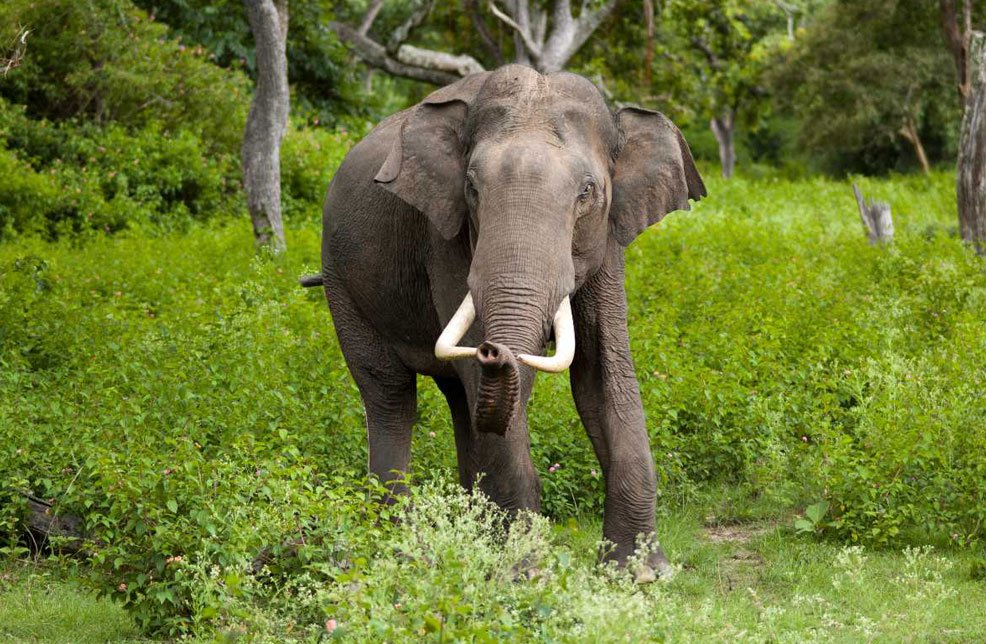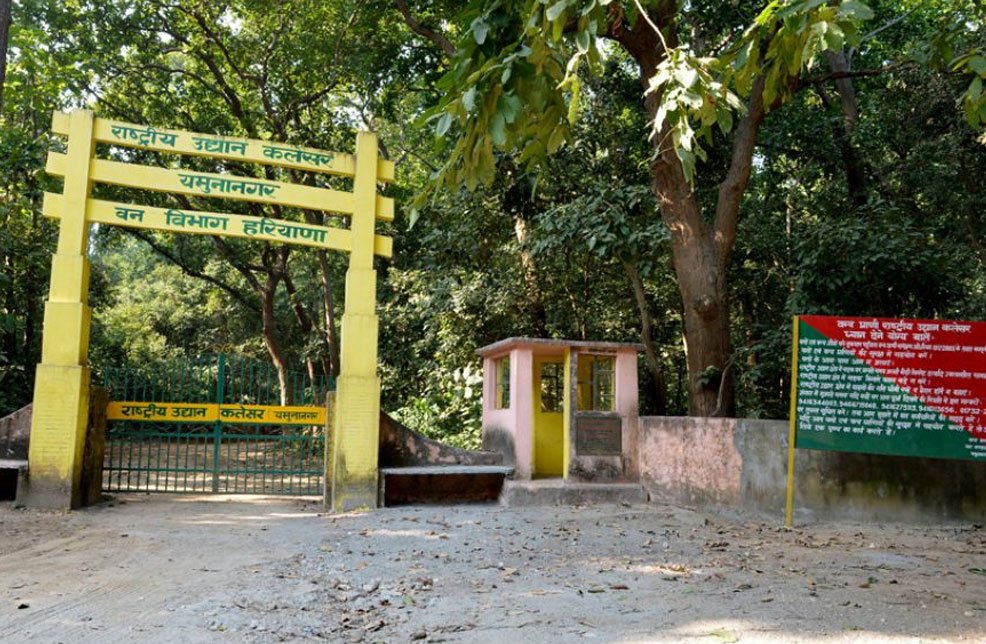Kalesar Wildlife Sanctuary Yamuna Nagar is a protected wildlife reserve located in the eastern part of Yamunanagar district in the Indian state of Haryana. Covering an area of 11,000 acres, it is situated in the Shivalik foothills of the Himalayas and is home to a variety of flora and fauna. The sanctuary derives its name from the Kalesar forest, which is a part of the reserve.
The Kalesar Wildlife Sanctuary is home to many species of animals, including leopards, sambar deer, barking deer, hyenas, jackals, Indian porcupines, Indian pangolins, and langurs. The sanctuary is also home to several species of birds, such as the red junglefowl, grey partridge, Indian peafowl, and white-throated kingfisher.

Timings :
Summer months
06:00 AM to 10:00 AM
04:00 PM to 07:00 PM
Winter months
07:00 AM to 11:00 AM
03:30 PM to 06:00 PM
The park remains closed from July to September.
Time Required : 3-4 hours
Entry Fee :
Indians: INR 30
Foreign nationals: INR 100
Safari: INR 100
Videography: INR 100
Apart from its rich wildlife, the sanctuary is also known for its scenic beauty. The Kalesar forest boasts a dense cover of Sal trees, which is an important tree species for the production of timber and paper. The sanctuary is also a popular destination for trekking and hiking enthusiasts, who come to explore the beautiful hills and forests.
In addition to its natural attractions, the Kalesar Wildlife Sanctuary also has historical significance. The sanctuary houses the Kalesar Fort, which is believed to have been built during the reign of the Mughal emperor Aurangzeb. The fort is located atop a hill and offers a panoramic view of the surrounding forests and hills. Overall, the Kalesar Wildlife Sanctuary is a must-visit destination for nature lovers and wildlife enthusiasts alike.
History of Kalesar Wildlife Sanctuary Yamuna Nagar
The place was deemed to be a national park on 8 December 2003. It was named after a temple (known as Kalesar Mahadev temple) located inside the premise of the park. In earlier times, rulers under the Mughal and British Raj used the park as hunting grounds. They mainly hunted tigers. Around 1892, the number of tigers in the area reduced significantly. The numbers went alarmingly low, and thus, hunting was banned in the park in the early 20th century.

The park is also famous for its Dak bungalows – the administrative architectural bungalows built in colonial times. All these structures go back to the 1900s. Their dominant features are high ceilings, teak panelings, unique parquet flooring, and antique furniture. A fireplace combined with a mantelpiece over it completes this periodical setting.
The geographical location of Kalesar Wildlife Sanctuary
The Kalesar National Park is located in the Yamuna Nagar district in Haryana, It is about 15 km away from Paonta Sahib, and about 7 km away from Hathni Kund Barrage. The park can be reached through these nearest towns and cities: Dehradun (about 55 km), Yamuna Nagar (about 42 km), Bilaspur (120 km), and Chandigarh (122 km) via NH 7 from Chandigarh. River Yamuna lies to its east. Rajaji National Park, which is located in Uttrakhand lies to the northeast of the park while the Simbalbara National Park nestled in Shivalik Hills lies to the north, sharing a border with Himachal Pradesh. In the west lies the Morni Hills. Agrarian farms lie in the west and south as well.
Attractions in Kalesar Wildlife Sanctuary in Yamunanagar

This location is primarily a forest consisting of Khair and Sal trees and boasts an abundance of biodiversity. The vast expanse of grasslands provides a home to a wide variety of plant and animal species. Visitors to this wildlife sanctuary may catch a glimpse of regal tigers and powerful elephants, who occasionally venture from the nearby Rajaji National Park. By improving the habitat conditions of this area, these wild animals could potentially establish this sanctuary as their permanent home.
A number of other creatures have also made this place their habitat, including the Monitor Lizard, Grey-hooded Warbler, King Cobra, Crested Serpent Eagle, Python, Chital, Chestnut-bellied Nuthatch, Sambar, Bar-tailed Treecreeper, Barking Deer, Ghoral, Red-billed Blue Magpie, and Leopard. The Ghoral typically resides in the rocky terrain of the Sivalik range hills.
The sanctuary houses numerous medicinal plants, with Sambar primarily inhabiting the slopes and Chital commonly found in the grasslands. The Red Jungle Fowl is a significant feature of this location, while the Rhesus Macaque monkey occasionally visits the area. Unfortunately, the Rhesus Macaque monkey’s presence poses a threat to the Red Jungle Fowl population as they rely on the bird’s eggs for sustenance.
Read More: Chaudhary Devi Lal Herbal Nature Park
Other Attractions at Kalesar National Park
- Kalesar Mahadev Temple
- Yamuna River bank
Best Time to Visit Kalesar Wildlife Sanctuary
The best time to visit the Kalesar National Park is between the months of October to March when the weather is pleasant and most of the animals can be easily sighted.
How to reach Kalesar Wildlife Sanctuary in Yamunanagar
It is very easy to reach Kalesar Wildlife Sanctuary from Yamunanagar as it is at a distance of 45 kilometers from Yamunanagar and the nearest railway station is the one located in Yamunanagar. The state highway of Yamunanagar passes through this place and there is good connectivity to this place from Yamunanagar by road one can reach this place very comfortably with the help of a car or a bus. Other places close to this place are Ponta which is at a distance of 15 kilometers and Dehradun, which is at a distance of 55 kilometers.
By train: The nearest station is Yamuna Nagar, which is about 35 km away from the park. You can get a taxi from there.
By road: All significant highways are connected to the park. The nearest cities are Yamuna Nagar (about 45 km) and Pounta Sahib (about 15 km).
By air: The nearest airport is Chandigarh (about 85 km). You can quickly get a taxi that will take you to the park.
Accommodation
Three rest houses are available (subject to a prior booking).
- Kalesar Woodland Rest House (managed by the Forest and wildlife department of Haryana) contact for booking Ph. 0171-2444237
- Hathini-Kund Irrigation Rest House (Managed by the Irrigation Department of Haryana)
- Tajewala Irrigation Rest House. (Irrigation Department)
If you are lucky, you can get a room at any of these beautiful rest houses and you can have a mesmerizing stay.
National Parks are always a great holiday destination – full of natural beauty, stunning flora and fauna, and long beautiful stretches of landscape. Plan a trip to Kalesar National Park for memorable stories.
Frequently Asked Questions about Kalesar Wildlife Sanctuary
Kalesar National Park is situated in the foothills of the Shiwalik ranges of the mighty Himalayas. On the map, it is located between 300 18′ to 300 27′ North latitude & 770 18′ to 770 35′ East longitude. It falls under Yamunanagar District of Haryana, sharing boundary with three States viz., Himachal Pradesh, Uttranchal & U.P.
The following are the timings for the summer and winter months:-
Summer: 06:00 AM to 10:00 AM and 04:00 PM to 07:00 PM
Winter: 07:00 AM to 11:00 AM and 03:30 PM to 06:00 PM
The best season for visiting the National Park during the year is in the month of November to December and March to June. The National Park remains closed in the months of July to September.
The entry fee for Kalesar Wildlife Sanctuary is INR 20 per person.
Kalesar Wildlife Sanctuary is home to a variety of wildlife species such as the Indian leopard, sambar deer, barking deer, blackbuck, Indian crested porcupine, Indian grey mongoose, and Indian pangolin.
No, there is no accommodation available inside the sanctuary. However, there are several accommodation options available in the nearby towns and cities.
The best time to visit Kalesar Wildlife Sanctuary is from October to March when the weather is pleasant and the animals are more active.
No, there are no safari options available at Kalesar Wildlife Sanctuary. However, visitors can go on nature walks and trekking trails.
Yes, visitors are required to follow certain guidelines while inside the sanctuary such as not littering, not disturbing the wildlife, and not carrying any plastic items inside the sanctuary.
Yes, visitors can hire a guide at the sanctuary for a fee. The guides are knowledgeable about wildlife and can provide valuable insights and information.
It is very easy to reach Kalesar Wildlife Sanctuary from Yamunanagar as it is at a distance of 45 kilometers from Yamunanagar and the nearest railway station is the one located in Yamunanagar. The state highway of Yamunanagar passes through this place and there is good connectivity to this place from Yamunanagar by road one can reach this place very comfortably with the help of a car or a bus. Other places close to this place are Ponta which is at a distance of 15 kilometers and Dehradun, which is at a distance of 55 kilometers.
By train: The nearest station is Yamuna Nagar, which is about 35 km away from the park. You can get a taxi from there.
By road: All significant highways are connected to the park. The nearest cities are Yamuna Nagar (about 45 km) and Pounta Sahib (about 15 km).
By air: The nearest airport is Chandigarh (about 85 km). You can quickly get a taxi that will take you to the park.


